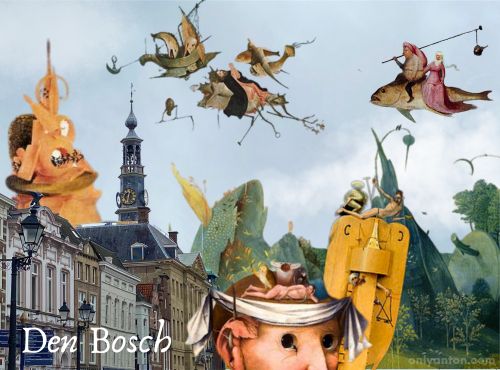
Introduction
Tucked away in the province of North Brabant, Den Bosch (‘s-Hertogenbosch) is one of the Netherlands’ best-kept secrets. It is a city steeped in medieval charm, artistic heritage, and culinary delights. It offers a rich experience beyond the usual Dutch travel itinerary. With its cobbled streets, gothic cathedrals, tranquil canals, and vibrant cafés, Den Bosch is a place where history and creativity intertwine. Despite its cultural significance, it remains delightfully underrated—a hidden gem waiting to be explored.
For me, Den Bosch was more than just another stop on my Netherlands journey. Before attending Dutch language classes in Drenthe, I made a special trip to this city for one reason: Hieronymus Bosch. As a longtime admirer of the fantastical and surreal works of this medieval master, I couldn’t pass up the opportunity to visit the Jheronimus Bosch Art Centre. The centre is dedicated to the visionary painter who once called Den Bosch home. But what I found was more than just an artistic pilgrimage. The city itself captivated me with its historical beauty, welcoming atmosphere, and, of course, its famous Bossche Bollen—a chocolate-covered, cream-filled pastry that’s worth the visit alone.
In this guide, I’ll take you through the best of Den Bosch, from its iconic landmarks and hidden corners to its artistic treasures and mouthwatering local specialties. Whether you’re drawn to its medieval architecture, scenic canals, or rich artistic legacy, this city offers an unforgettable experience for those who venture beyond the beaten path.
Locating Den Bosch: Geography and Setting
The Netherlands, famous for its tulip fields, windmills, and extensive canal networks, is strategically positioned in northwestern Europe. The country is bordered by Germany to the east and Belgium to the south. The Netherlands enjoys a North Sea coastline that has shaped its long history of trade, exploration, and maritime power. As one of the founding members of the European Union and home to key international institutions, the Netherlands plays an essential role in European politics, commerce, and innovation. With its well-connected transport system and compact size, the country is remarkably easy to explore, making even lesser-known cities like ‘s-Hertogenbosch (Den Bosch) easily accessible.
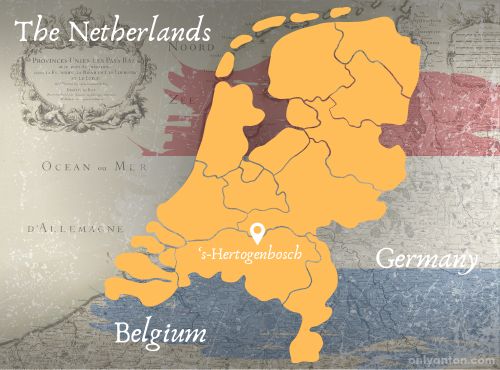
Where is ‘s-Hertogenbosch?
Located in the southern Netherlands, Den Bosch is the capital of the province of North Brabant. Den Bosch sits between two of the country’s largest cities—Utrecht to the north and Eindhoven to the south. This location makes for an easy day trip from major Dutch hubs like Amsterdam, Rotterdam, or The Hague. The city’s name, ‘s-Hertogenbosch, translates to “The Duke’s Forest,” a nod to its medieval origins. While the official name appears on maps and signs, most people—including locals—simply call it Den Bosch.
Why Visit?
While many travellers flock to Amsterdam or Rotterdam, Den Bosch offers a more authentic, off-the-beaten-path experience. Its historic charm, winding canals, and lively café culture make it an ideal destination for those looking to explore the Netherlands beyond its major tourist centers. The city boasts stunning medieval architecture. One example is the impressive Sint-Janskathedraal. There is also a thriving art scene that has a deep connection to its most famous resident, Hieronymus Bosch. Add to that a fantastic food culture, a welcoming atmosphere, and a calendar full of cultural events, and it’s easy to see why Den Bosch is a hidden gem worth discovering.
History and Culture of Den Bosch
With its cobblestone streets, Gothic spires, and centuries-old traditions, Den Bosch is a city that wears its history proudly. From its medieval fortifications to its thriving modern art scene, the city offers a rich blend of past and present. It is an engaging destination for history buffs, art lovers, and cultural explorers.
Medieval and Renaissance Legacy
Den Bosch traces its origins back to the 12th century. Den Bosch was granted city rights in 1185 by Duke Henry I of Brabant. Its strategic location along important trade routes allowed it to flourish as a center of commerce, particularly in textiles and metalwork. The city was heavily fortified to protect its prosperity. The impressive walls, gates, and a canal system still shape its layout today. Unlike many other Dutch cities, Den Bosch’s medieval center survived largely intact. Visitors can walk through streets that feel untouched by time. The Bossche Markt is the city’s central square. It remains a vibrant hub of activity, lined with centuries-old buildings and home to a statue of its most famous son—Hieronymus Bosch.
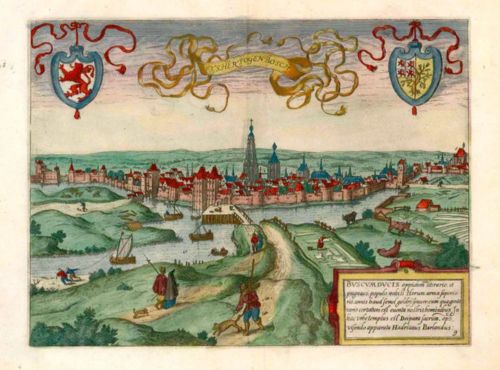
The Artistic and Religious Influence
Den Bosch’s most renowned artistic legacy is its connection to Hieronymus Bosch (c. 1450–1516), the groundbreaking painter known for his surreal and fantastical visions. His otherworldly creatures and apocalyptic landscapes continue to fascinate art enthusiasts. The city proudly celebrates his work at the Jheronimus Bosch Art Centre.
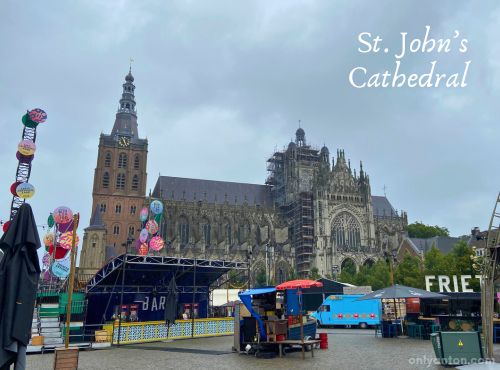
Beyond art, Den Bosch has long been an important Catholic stronghold in the Netherlands. The city’s magnificent Sint-Janskathedraal (St. John’s Cathedral) is a masterpiece of Gothic architecture. Intricate carvings and stunning stained glass fill the church. Nearby is the Chapel of the Illustrious Brotherhood of Our Blessed Lady. This prestigious religious order offers further insight into the city’s deep Catholic roots. Another unique local tradition is Carnival when Den Bosch transforms into ‘Oeteldonk.’ This is the city’s alternate identity, full of festive parades, elaborate costumes, and an unmistakable sense of community spirit.
Modern-Day Den Bosch
While history defines much of Den Bosch’s character, the city has embraced contemporary creativity with open arms. The Tramkade, a former industrial zone, has been reinvented as a lively hub for street art, music, and nightlife. The Verkadefabriek is a repurposed cookie factory that now serves as a cultural center offering theatre, film, and live performances. This fusion of the old and the new makes Den Bosch a city that doesn’t just preserve its past but actively builds upon it, creating an atmosphere that is both historic and dynamic.
Must-See Sights in Den Bosch
Den Bosch is a city that blends history, art, and culture in a way that feels both timeless and vibrant. Whether you’re exploring its medieval landmarks, soaking in its artistic legacy, or wandering through its picturesque streets, there’s no shortage of fascinating sights to discover. Here are some of the must-see attractions that make Den Bosch a hidden gem worth exploring.
Jheronimus Bosch Art Centre
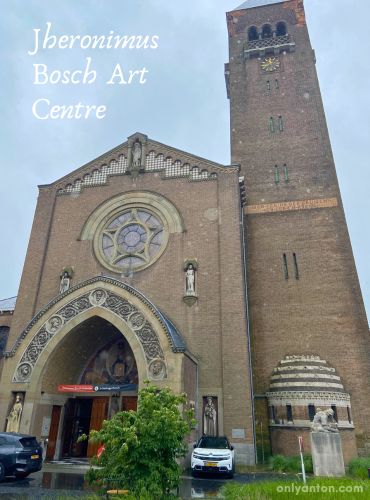
For art lovers and admirers of the strange and surreal, the Jheronimus Bosch Art Centre is a must-visit. Dedicated to Hieronymus Bosch, the city’s most famous son, this museum provides an immersive look into the visionary painter’s world. The museum doesn’t hold original Bosch works. Most of his paintings are scattered throughout Europe and around the world in major collections. Still, the centre offers high-quality reproductions, digital displays, and interactive exhibits that bring his nightmarish yet fascinating imagery to life. Housed in a former church, the space itself adds to the otherworldly atmosphere. It is a fitting tribute to Bosch’s enduring legacy.
Sint-Janskathedraal (St. John’s Cathedral)
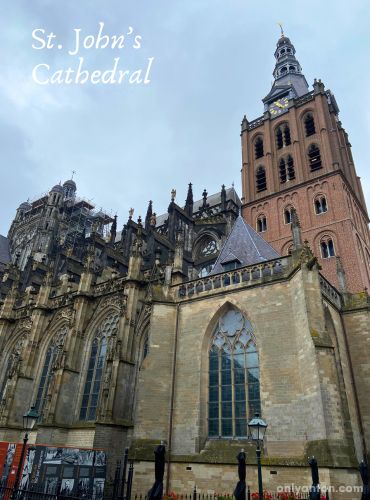

Sint-Janskathedraal is one of the most impressive Gothic cathedrals in the Netherlands. The structure dominates Den Bosch’s skyline with its soaring towers and intricate facade. Built between the 14th and 16th centuries, this stunning place of worship is famous for its detailed sculptures. Many sculptures depict angels in unexpected forms—including one with a modern wristwatch. The cathedral features exquisite stained glass windows, an ornately carved pulpit, and an atmosphere steeped in history and reverence. For those willing to climb to the top, the views over the city are spectacular.
Het Zwanenbroedershuis (Swan Brothers House Museum)
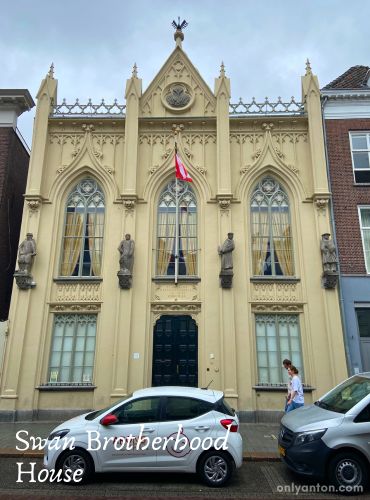
For a deeper dive into Den Bosch’s religious and cultural heritage, you might want to visit Het Zwanenbroedershuis. This museum is dedicated to the Illustrious Brotherhood of Our Blessed Lady, a prestigious religious order founded in the 14th century. The exhibits showcase religious artifacts, historical documents, and intricate artworks, providing insight into the city’s long-standing Catholic traditions and its elite brotherhood’s influence. Famous past members included William the Silent and Hieronymus Bosch himself.
De Bossche Markt
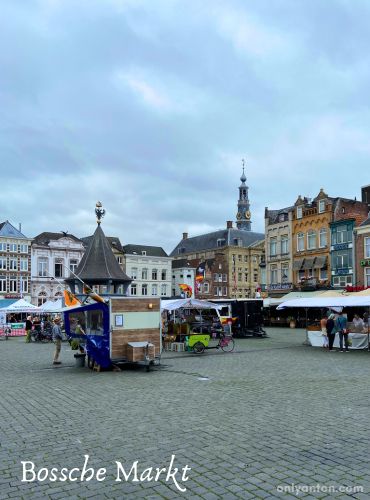
At the city’s heart lies De Bossche Markt. The historic market square has been a centre of commerce and gathering for centuries. Charming medieval buildings, lively cafés, and bustling shops surround the square. In the middle of the square stands a statue of Hieronymus Bosch, a constant reminder of the city’s deep artistic roots. The market square is the perfect place to soak in the city’s energy. Grab a coffee, sample local street food, or simply enjoy the lively atmosphere.
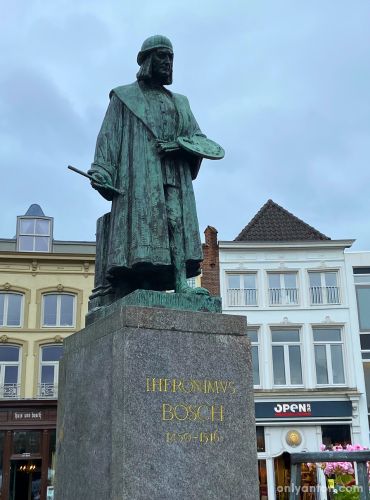

Just off the southern edge of the square, you’ll find the House of Bosch (Het Huis van Bosch) at Markt 29. This place was once the home and workshop of Hieronymus Bosch. Antonius van Aken, father of Hieronymus Bosch, purchased the historic building. Bosch trained in this location until his marriage. The meticulously restored house is now a national monument. It offers a fascinating glimpse into the early life and creative beginnings of Den Bosch’s most famous son.
Drakenfontein (The Golden Dragon Fountain)
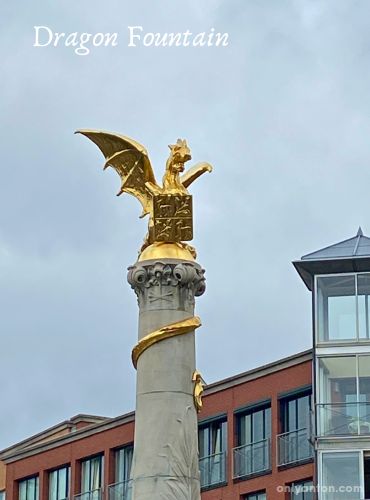
Just outside the central train station is the Drakenfontein—also known as The Golden Dragon Fountain. The striking landmark greets visitors upon arrival in Den Bosch. The gilded dragon atop the fountain symbolizes the city’s pride and history. The fountain serves as both a meeting point and a quintessential photo spot. While it may not be as historically significant as other sites, the Drakenfontein remains one of the city’s most recognizable symbols.
Optional Sights:
If you have extra time in Den Bosch, here are a few more noteworthy sights:
- Het Noordbrabants Museum – A fascinating museum featuring Dutch and Brabantine art, including works related to Hieronymus Bosch, Vincent van Gogh, and the cultural heritage of North Brabant.
- Kasteel Maurick – A picturesque castle just outside Den Bosch, offering scenic walking trails and a fine dining restaurant for those looking for a regal escape.
- Binnendieze Canal Tours – A unique way to explore Den Bosch, these boat tours take you through the city’s hidden waterways, passing under medieval bridges and offering a different perspective on the city’s history.
- Korte Putstraat – For a taste of local nightlife, this narrow, atmospheric street is packed with bars, restaurants, and cafés, making it the perfect place to enjoy a meal and a drink in a lively setting.
With its blend of historic grandeur, artistic heritage, and vibrant social life, Den Bosch is a city full of surprises. It is a place where every street, canal, and square has a story to tell.
Den Bosch and Hieronymus Bosch
Among the many historical figures associated with the Netherlands, Hieronymus Bosch stands apart as one of the most enigmatic and imaginative painters of all time. His intricate, surreal, and often nightmarish visions have fascinated and puzzled art lovers for centuries. Den Bosch is the city where he was born, lived, and worked. The painter’s legacy is still deeply woven into the cultural fabric of the city, making it a pilgrimage site for fans of his art.
Who Was Hieronymus Bosch?
Jheronimus van Aken, known to history as Hieronymus Bosch, was born around 1450 in ‘s-Hertobgenbosch. He became one of the most influential artists of the Northern Renaissance. Many of his contemporaries painted serene religious imagery or courtly scenes. Bosch, on the other hand, created intricate, otherworldly compositions filled with grotesque creatures, hybrid beings, and apocalyptic landscapes. His best-known work, The Garden of Earthly Delights, is a sprawling triptych filled with vivid, surreal imagery that continues to intrigue and mystify scholars and viewers alike.
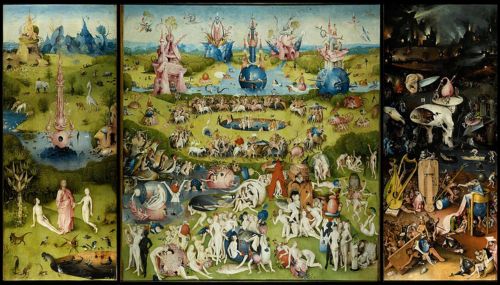
Despite the bizarre nature of his paintings, Bosch was highly respected in his time. His works carried deep moral, religious, and allegorical themes, reflecting the anxieties of the late medieval period. His unique artistic approach set him apart, earning him commissions from nobles, clergy, and even the Spanish monarchy.
Why He Matters
Bosch’s influence stretches far beyond the 15th century. His fantastical creatures and distorted, dreamlike imagery predated and inspired later movements like Surrealism. Bosch’s influence can be discerned in the work of artists such as Salvador Dalí and Max Ernst. Bosch’s detailed narrative style also left a mark on fantasy art, modern illustration, and even contemporary film and video game aesthetics. Religious scholars continue to study his paintings for their symbolism and warnings about human folly. As a consequence, Bosch is one of the most widely interpreted and debated painters in Western art history.
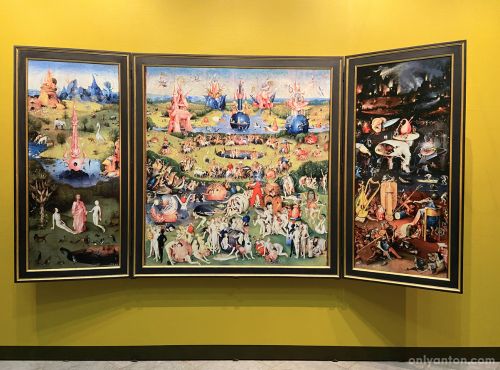
Experiencing Bosch in Den Bosch
For those eager to immerse themselves in Bosch’s strange and captivating world, the Jheronimus Bosch Art Centre is an absolute must-visit. Housed in a former church, this museum provides an interactive and immersive experience, showcasing high-quality reproductions of Bosch’s paintings, large-scale details of his most famous works, and insightful exhibitions on his life and themes. While the originals are housed in museums across Madrid, Vienna, and Bruges, the centre allows visitors to engage with faithful recreations, digital projections, and sculptural interpretations of Bosch’s creations.

One of the highlights of the museum is the opportunity to see close-up details of Bosch’s works that are often difficult to appreciate in their original size. The museum also provides contextual history, explaining how Bosch’s hometown and his membership in the religious Illustrious Brotherhood of Our Blessed Lady may have influenced his artistic vision. For art lovers, scholars, and curious travellers, the Jheronimus Bosch Art Centre is the best place in the world to gain a deeper appreciation of this unique master’s mind.
The Bosch Legacy
Bosch’s presence in Den Bosch goes beyond the museum walls. The city celebrates his legacy in creative and imaginative ways, ensuring that his spirit of artistic curiosity lives on. One of the most unique tributes is the Bosch Parade, an annual event where artists, designers, and performers create surreal, floating art pieces inspired by Bosch’s work. This theatrical water procession is held on the city’s canals and transforms Den Bosch into a living Boschian dreamscape.
![Stock image of the Bosch Parade in ‘s-Hertogenbosch. Foto van editie 2019, In De Buurt: Ben Nienhuis. [Image by Ben Nienhuis]](https://onlyanton.com/wp-content/uploads/2025/02/Bosch-Parade.jpg)
Beyond the parade, one can find Bosch’s influence throughout the city. Sculptures and modern reinterpretations of his creatures peek out from building façades, fountains, and street corners, offering subtle nods to his fantastical world. Even visitors simply wandering the streets of Den Bosch will encounter Bosch’s presence in unexpected places, reinforcing why this city remains the true heart of his mystical and imaginative legacy.
Den Bosch Food Guide
A visit to Den Bosch wouldn’t be complete without indulging in its delicious local cuisine, where sweet treats, hearty snacks, and Dutch beer culture come together to offer an authentic taste of North Brabant. From rich, chocolate-filled Bossche Bollen to savoury Dutch specialties, Den Bosch serves up flavours to satisfy every craving.
Bossche Bollen: The Pride of Den Bosch
If there is one food item that defines Den Bosch, it’s the Bossche Bol. This oversized, chocolate-covered cream puff is a local specialty that has delighted visitors and residents for generations. Imagine a light and airy pastry shell generously filled with sweet whipped cream, then coated in a thick layer of rich, glossy chocolate—pure indulgence.
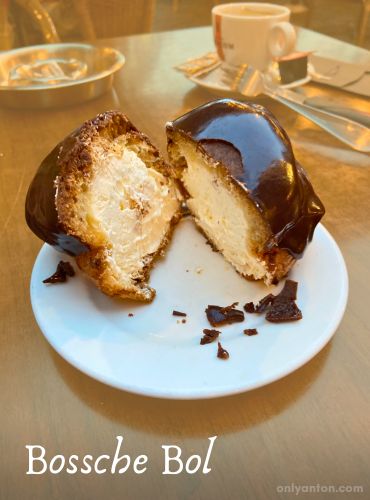
During my time in Den Bosch, I had the pleasure of trying this decadent dessert at Brasserie Top, a cozy spot on the edge of De Bossche Markt Square. The combination of crisp pastry, fluffy cream, and silky chocolate was heavenly. Though Jan de Groot is the most famous bakery for Bossche Bollen, known for drawing long lines of eager customers, I can confidently say that Brasserie Top’s version was just as exceptional.
Savoury Dutch Specialties
Beyond its famous sweet treat, Den Bosch also offers a variety of savoury Dutch delights, perfect for snacking while exploring the city. Here are a few must-try options.
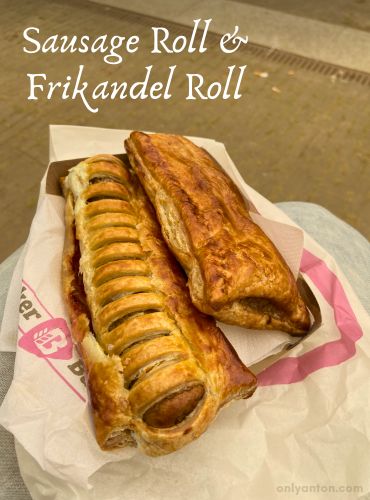
Saucijssenbroodjes (Worstenbroodjes)
These Dutch sausage rolls are a satisfying and flavourful snack featuring a spiced meat filling wrapped in flaky pastry. They’re a popular on-the-go bite, especially among locals.
Frikandelbroodje
A spiced, skinless sausage (frikandel) wrapped in flaky puff pastry, baked until golden brown, and often served warm. Hungry eaters typically enjoy it with curry ketchup or mustard for extra flavour. This hearty, savoury treat is common in Dutch bakeries, supermarkets, and snack bars, making it an ideal choice for a quick bite while exploring the city.
Kaasbroodjes
A variation of the sausage roll filled with melted cheese instead of meat. The buttery, crisp exterior and gooey interior make it an irresistible choice for cheese lovers.
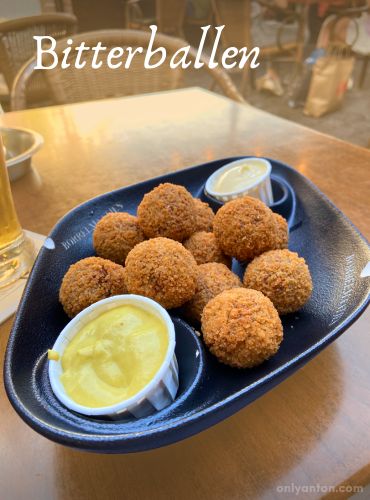
Bitterballen
One of the Netherlands’ most beloved bar snacks, these crispy, deep-fried croquettes are filled with rich, meaty ragout and served with spicy Dutch mustard. Best enjoyed alongside a cold beer at one of the city’s many pubs.
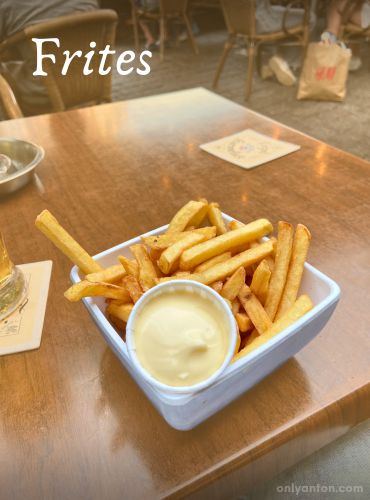
Frites with Fritesaus
A Dutch take on fries, these crispy golden potatoes are typically served with fritesaus, a smooth, slightly tangy mayonnaise-based sauce that adds a creamy richness to every bite.
Drinks to Try
Den Bosch also has a strong beer and spirits culture, offering visitors a chance to enjoy both Dutch and Belgian brews as well as a few unique local specialties.
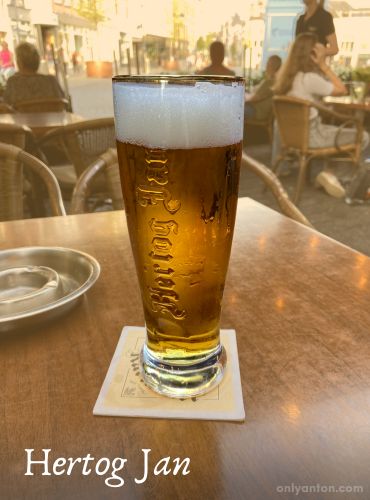
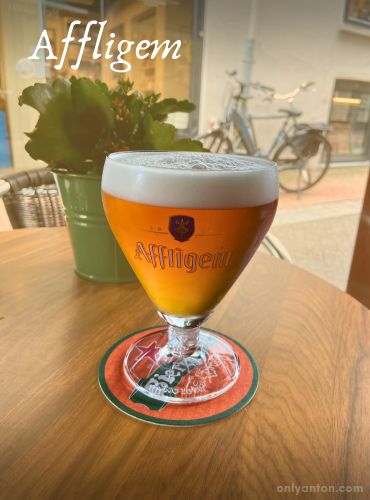
Dutch and Belgian Beers
The Netherlands and Belgium are famous for their high-quality beers, and Den Bosch is no exception. Popular choices include Affligem, Hertog Jan, Oedipus, and, of course, Heineken. Many local pubs offer a wide selection of regional and craft brews, perfect for an afternoon or evening of relaxed sipping.
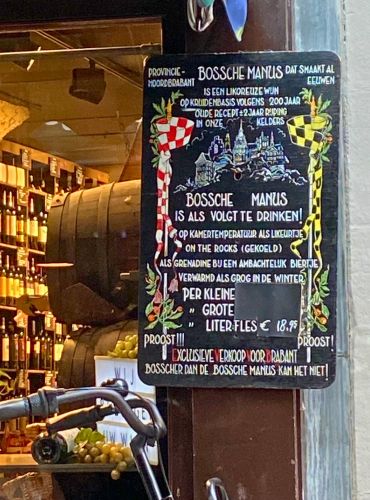
Bossche Manus
For those seeking something distinctly local, Bossche Manus is a herbal, licorice-flavoured liqueur unique to Den Bosch. Its bold, slightly bitter taste is an acquired one, but it offers a memorable experience for adventurous drinkers.
From indulgent pastries to hearty Dutch snacks and rich, flavorful beers, Den Bosch’s culinary scene is a delightful mix of tradition and indulgence—perfect for food lovers eager to experience authentic North Brabant flavours.
Practical Tips for Visiting Den Bosch
Den Bosch is a welcoming and easily navigable city, making it an excellent destination for travellers who appreciate a mix of history, culture, and local charm. Whether you’re visiting for the art, architecture, or food, some planning will help you make the most of your time in this hidden gem of the Netherlands.
Getting There
Den Bosch is well-connected to the rest of the Netherlands, making it an easy day trip or weekend getaway from major cities.
- By Train – The most convenient way to reach Den Bosch is by train. Direct routes connect it to Amsterdam (just over an hour), Utrecht (30 minutes), and Eindhoven (20 minutes). The centrally located Den Bosch train station makes arriving by rail a breeze.
- By Car – If you’re driving, Den Bosch is located near the A2 motorway, offering an easy route from Amsterdam, Utrecht, or Maastricht. However, parking in the city center can be sparse, so consider using Park+Ride facilities outside the central area.
- By Bus – Regional and intercity buses also connect Den Bosch to other parts of the Netherlands, though they are generally slower than the train.
Getting Around
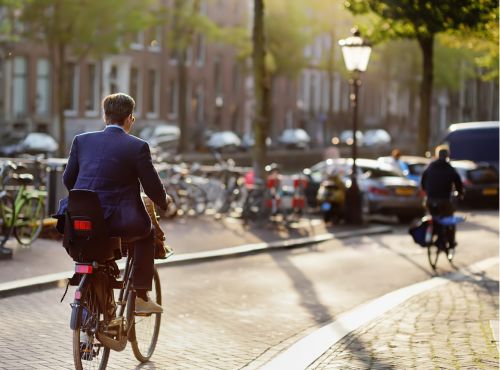
One of the best things about Den Bosch is its compact and walkable city center, allowing visitors to explore on foot easily.
- Walking – The historic core is best explored on foot, with charming streets, canals, and squares within easy walking distance.
- Biking – As with much of the Netherlands, biking is a popular and efficient way to get around. Rent a fiets (bike) from the train station or a local rental shop for a more local experience.
- Public Transport – Den Bosch has a reliable local bus network for those needing to travel beyond the city center. The Arriva buses connect various neighbourhoods and nearby villages.
Best Time to Visit
Den Bosch offers something unique in every season, making it a year-round destination.
- Carnival Season (February/March) – Den Bosch transforms into Oeteldonk, with colourful parades, live music, and a vibrant party atmosphere. This Carnival celebration is one of the most famous in the Netherlands.
- Spring & Summer (April–August) – Warm weather makes canal tours, open-air cafés, and outdoor festivals especially enjoyable. The city’s green spaces and riverside walks are at their best.
- Autumn (September–November) – The changing leaves and crisp air make this a picturesque and quieter time to visit, perfect for enjoying museums, cozy cafés, and cultural events.
Cultural Etiquette
The Dutch are known for being friendly yet direct, and Den Bosch embodies this welcoming yet down-to-earth attitude. Here are a few etiquette tips to keep in mind.

Basic Dutch Phrases
While most locals speak excellent English, knowing a few Dutch words can go a long way:
- Hallo! (Hello!)
- Dank je wel! (Thank you!)
- Alsjeblieft! (Please/Here you go!)
- Gezellig! – This untranslatable Dutch word captures coziness, friendliness, and good vibes, making it perfect for describing the atmosphere of Den Bosch.
Dining Etiquette
In restaurants and cafés, it’s common to wave or make eye contact with the staff to get service. Tipping around 5-10% is appreciated but not mandatory.
Dutch Bluntness
The Dutch are famously direct, which might come across as blunt or even rude to some visitors. Don’t be offended—it’s just their way of being honest and efficient in conversation!
With efficient transport, a walkable city center, and a welcoming atmosphere, Den Bosch is a delight to explore. Meander through its historic streets, cycle along the canals, or relax with a Bossche Bol in a cozy café.
Conclusion
Den Bosch may not be the first city that comes to mind when planning a trip to the Netherlands, but for those seeking history, art, and authentic Dutch charm, it is a hidden gem worth exploring. With its well-preserved medieval architecture, vibrant cultural scene, and deep connection to Hieronymus Bosch, the city offers an experience that blends old-world mystique with contemporary energy. Admire the Gothic grandeur of Sint-Janskathedraal, wander the cobbled streets of the historic center, or treat yourself to a decadent Bossche Bol. Den Bosch rewards curious travellers with its rich character and warm hospitality.
For me, the highlight of the visit was standing in the Jheronimus Bosch Art Centre, surrounded by the surreal, intricate worlds of one of my favourite artists. Seeing the city that shaped his imagination added another layer of appreciation to his visionary work. Beyond Bosch, Den Bosch surprised me—its medieval beauty, lively markets, and welcoming atmosphere made for an unforgettable stop on my Netherlands journey.
If you’re looking to step beyond the usual Dutch tourist trail, Den Bosch is waiting to be explored. Whether it’s the city’s artistic legacy, historic charm, or culinary traditions that capture your attention, Den Bosch leaves a lasting impression.
What About You?
Have you ever visited ‘s-Hertogenbosch, or is it now on your travel list? If you’ve been, what were your favourite experiences—was it the stunning Sint-Janskathedraal, the Jheronimus Bosch Art Centre, or maybe a bite of Bossche Bollen? If you haven’t yet explored Den Bosch, does this hidden gem intrigue you?
I’d love to hear about your Dutch travel discoveries! What lesser-known towns or cultural experiences in the Netherlands have left a lasting impression on you? Share your thoughts in the comments!
Looking for more European destinations to explore? Check out my other travel guides on the Only Anton blog, including Bratislava, Budapest, and Vienna!
Further Reading and Resources
Related Posts on Only Anton
- Nijmegen’s Four Days Festival: Discover the magic of Nijmegen’s famous walking festival, a celebration of endurance, culture, and community.
- Discovering Ghent: Belgium’s Overlooked Medieval Gem: Uncover the medieval beauty of Ghent, Belgium, and explore its rich history, vibrant cultural scene, and stunning architecture.
- Aachen Travel Guide: Step into the history of Aachen, Germany, a city of Charlemagne’s legacy, hot springs, and Gothic splendour.
External Resources
For those looking to explore more about Den Bosch and its offerings, these resources provide helpful travel tips, history, and cultural insights:
- Jheronimus Bosch Art Centre: Learn more about the life and works of Hieronymus Bosch at this unique museum dedicated to the city’s most famous artist.
- Het Noordbrabants Museum: Discover exhibitions on Brabantine art and history, featuring works by Bosch, Van Gogh, and contemporary Dutch artists.
- Dagje Den Bosch: A tourism website with information on many sights and activities, including the Bosch House, Binnendieze boat tours, and city walks.
- Jan de Groot: Visit the home of the famous Bossche Bollen, Den Bosch’s most beloved pastry.
- Visit Brabant (Official Tourism Site): Find travel tips, local events, and destination guides for Den Bosch and the greater Brabant region.




